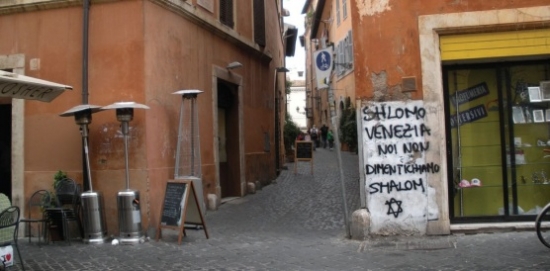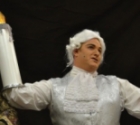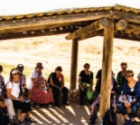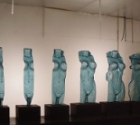
Whilst cruising the Western Mediterranean, our ship made its last port of call at Civitavecchia, which is some 80 kilometers away from Rome. We chose a simple bus ride with a guide en route and then took time out to explore a part of the city on our own. We knew exactly where we wished to visit; not the Vatican or the cathedrals, but the place nearest to our hearts. That was the Ghetto.
On hearing that we were Israelis, our well-informed guide encouraged our decision. He gave us a short description of the area and its history, telling us that a visit to the Jewish Museum, which is situated in the complex of the Great Synagogue, must be our first stop-off. He also recommended a family-run restaurant, where he especially likes to savor the Jewish food!
We took a taxi on the short ride from near the Vatican, over the Tiber River on the oldest bridge in Rome - Ponte Fabricio - to our destination. In days of the past it was referred to as Pons Judaeocum - “Jews’ Bridge” - since not only the Jews of Rome but also other foreigners were not permitted to live in central Rome, and had to live on the other side of the river. It was in the 16th century that Pope Paul IV made it mandatory for all Jews to live in this walled-off area. There was overcrowding and rampant poverty caused by the loss of rights of ownership or employment outside the neighborhood. Due to recurrent flooding from the Tiber River and their abysmal sanitary conditions, disease and death were prevalent.
The word "ghetto" comes from the Italian word borghetto which was first used in Venice when referring to the walled area outside the city walls where the Jews were compelled to live. In 1798 Papal power was annulled and there was no longer a necessity for the Jews to live in a ghetto. However Papal power was restored in 1799 and all Jews were again compelled to return to the ghettos and so this segregation continued on and off for another century. At last, the Papal States ceased to exist altogether and power went to the Kingdom of Italy. So from 1882 Jews were completely free to build new lives.
In 1888 the walls were torn down, many areas of the ghetto were demolished and reconstruction began. The original core remained untouched and it was there that the Jewish community chose to rebuild their new synagogue on the original site, and it is there that one can walk around and return in thought to times of the past.
The newly built Synagogue of Emancipation was opened in 1904; it is a striking building which brings to mind a small cathedral rather than a place of worship for the Jewish people. As there were no Jewish architects or craftsmen available due to the years of oppression, the synagogue was designed by Christians, but they did make efforts to respect the Jewish people. As a result, the main feature of the building is an impressive square dome, rather than a round one. The inside of the dome is painted in the colors of the rainbow, which are meant to symbolize God’s promise to Noah that there would be no more floods. Stars embellishing the ceiling again symbolize another of God’s promises - that Abraham’s descendants would flourish and be as many as the stars in the sky.
In 1960 an impressive museum was opened within the complex where one can view fascinating objects rescued not only from the ghetto but from all of Europe. Art objects and precious documents tell a 2000-year-old story of the Roman Jews.
In 1967, many Jews, fugitives from Libya, made their new home in Rome, and there is a section paying respect to their history and vibrant background. There is also a film that deals with the Nazi occupation of Rome and its outcome for the Jews. As is written on the program: “We have been here for 22 centuries. Got stories to tell.” Indeed, many touching stories are covered.
Needing some refreshment after a thought-provoking visit, we headed out into the autumn sunshine which came after heavy morning showers, but fortunately, nowadays the Tiber can deal with this. We went towards what is left of the ghetto, known as the main drag, where the Jewish school still exists. We made our way down the old cobbled streets which are lined with the remainder of the original tenement buildings and where every few steps brought us past signs of “Kosher Food” until we found the recommended restaurant, “Nonna Betta”. After enjoying a warm welcome, a delicious lunch and even discovering that the owner was related to an Italian family whom we knew in Israel, we could understand the recommendation of our guide.
As we hastened back to the meeting point with the bus, we noticed posters for community events and even political graffiti, both pro- and anti-Israel. We stopped to delight in the fountain, a Mannerist work of the past that later had turtles added to it by the artist, Bernini, who gave honor to the Jews. His carving links them to these ancient creatures that must carry their belongings on their backs!
The area has become one of Rome’s popular visiting places not only to Jewish tourists but also to others, drawn both by the food and by its poignant history. As one Christian tourist wrote: “The atmosphere is amazing. A must if you visit Rome. If you can, try to get a guided tour through the city which will be part of the walking tour. So much history to learn and to understand.”
And those were our thoughts too.
 Milestones 168
Milestones 168 “Be our Guest” at Beauty and the Beast
“Be our Guest” at Beauty and the Beast Advertisers List
Advertisers List From Bible to Bedouins and Battles
From Bible to Bedouins and Battles Trip to the Dead Sea
Trip to the Dead Sea Japan
Japan Barbara Abraham
Barbara Abraham